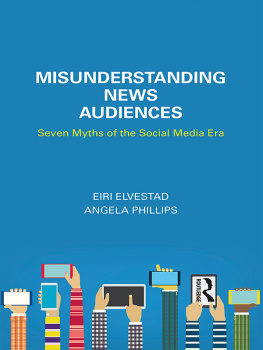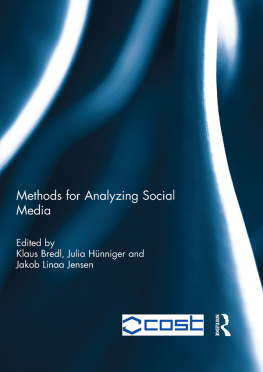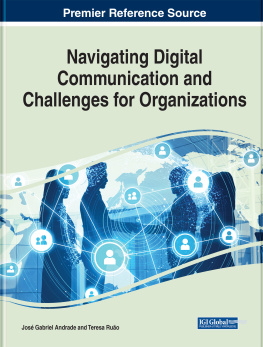
Key Concerns in Media Studies
Series editor: Andrew Crisell
Within the context of todays global, digital environment, Key Concerns in Media Studies addresses themes and concepts that are integral to the study of media. Concisely written by leading academics, the books consider the historical development of these themes and the theories that underpin them, and assess their overall significance, using up-to-date examples and case studies throughout. By giving a clear overview of each topic, the series provides an ideal starting point for all students of modern media.
Published
Paul Bowman Culture and the Media
Andrew Crisell Liveness and Recording in the Media
Stuart Cunningham, Terry Flew and Adam Swift Media Economics
Tim Dwyer Legal and Ethical Issues in the Media
Katie Ellis and Gerard Goggin Disability and the Media
Gerard Goggin New Technologies and the Media
David Hendy Public Service Broadcasting
Monika Metykova Diversity and the Media
Shaun Moores Media, Place and Mobility
Sarah Niblock Media Professionalism and Training
Sean Redmond Celebrity and the Media
Niall Richardson and Sadie Wearing Gender in the Media
Sue Turnbull Media Audiences
Sue Turnbull, under exclusive licence to Macmillan Education Limited 2020
All rights reserved. No reproduction, copy or transmission of this publication may be made without written permission.
No portion of this publication may be reproduced, copied or transmitted save with written permission or in accordance with the provisions of the Copyright, Designs and Patents Act 1988, or under the terms of any licence permitting limited copying issued by the Copyright Licensing Agency, Saffron House, 610 Kirby Street, London EC1N 8TS.
Any person who does any unauthorized act in relation to this publication may be liable to criminal prosecution and civil claims for damages.
The author has asserted her right to be identified as the author of this work in accordance with the Copyright, Designs and Patents Act 1988.
First published 2020 by
RED GLOBE PRESS
Red Globe Press in the UK is an imprint of Macmillan Education Limited, registered in England, company number 01755588, of 4 Crinan Street, London, N1 9XW.
Red Globe Press is a registered trademark in the United States, the United Kingdom, Europe and other countries.
ISBN 978-1-352-00958-3 hardback
ISBN 978-1-137-40510-4 paperback
This book is printed on paper suitable for recycling and made from fully managed and sustained forest sources. Logging, pulping and manufacturing processes are expected to conform to the environmental regulations of the country of origin.
A catalogue record for this book is available from the British Library.
A catalog record for this book is available from the Library of Congress.
Contents
List of Illustrations and Figure
Illustrations
Figure
Acknowledgements
This book has been a long time in the making. For their patience and encouragement, Id like to thank series editor, Andrew Crisell, and all the Palgrave Macmillan and Red Globe Press staff who have provided their assistance over the intervening years. For introducing me to the field of audience research, Id like to thank Peter B. White for his timely introduction to the remarkable TV series Prisoner Cell Block H and its teen audiences in 1984. Id also like to thank Robyn Penman for her guidance and insistence on the importance of communication in the formation of our social experiences of the world. My colleagues and students at the University of Wollongong continue to sustain me with their good humour, invaluable insights and their ongoing interest in this project. Particular thanks are due to Kate Bowles, Renee Middlemost, Chris Moore and Ika Willis, the tireless cheer squad every academic needs, and Kai Soh for much needed last minute assistance. Last but by no means least, thanks to my family, Will and Rick, for everything else.
Introductions
Its 1987 and Im on my way from one side (the outer east) of Melbournes vast suburban sprawl, to the other (the inner west), to undertake a year-long study of the role of the media in the lives of a group of young women in a girls secondary school. Ive not long been in Australia (three years), and am only just beginning to get a handle on its troubled settlercolonial history and social complexities. As will become apparent, the 50-minute car drive (on a good day) that transports me from my home in a leafy suburb populated by middle-class Anglo-Australians and migrants from northern Europe, who arrived before the Second World War, to the state-funded high school in a working-class inner-city suburb that has witnessed waves of post-war migration, is about to present me with a whole set of new challenges in thinking about Australia, people and the media in their lives.
This is the formative experience that will underpin my approach to audience research over the next 30 years as the media landscape has gradually evolved, and I am returning to this experience because, after accepting the challenge of writing a book about audiences in a series entitled Key Concerns in Media Studies, when it came to the point of defining just what those current concerns might be, I hesitated. While I have been encouraging undergraduate and postgraduate students to embrace audience research for the last 30 years, when faced with trying to define the field, and how best to proceed, I needed some time to think this through. In a globalized, fragmented, converged digital media environment, is the concept of the media audience still viable, I wondered. As I hope this book will demonstrate, I think it is, but we can learn much from the past of media audience research in seeking to move forward. Inspired by the French axiom Reculer pour mieux sauter, which might be roughly translated as the value of retreating a few steps in order to make a better leap forward, I decided to return to the history of media audience research first. I wanted to explore once again the why, when, where and how of this complex field as it has developed over the years in order to suggest how we might proceed. What can we learn from this history that will help us understand how audiences manage the complex media environment in which they are embedded today? As will become evident, while audiences have always been active in their use of the media, every new media technology or form is almost always framed in terms of the imagined effects that it will have on the audience that consumes it.
The backstory
While an interest in media audiences arguably begins with the emergence of the steam-driven printing press media in the 19th century, my own interest in the field began in a very different time and place. As a teacher of English working in a secondary school outside Cambridge in the UK in the mid-1970s, I discovered that talking about the media with a group of students who were classified as disadvantaged was a way to get them to discuss, and even tentatively write about, films and TV shows which they had enjoyed. Some of these students came from tiny rural hamlets and had never been to Cambridge despite the fact they lived only 10 miles from the city centre. This was the class of no-hopers to whom, as a newly minted eager young teacher, I was supposed to give some cheer, and perhaps even some literacy skills. As I discovered, these students were avid consumers of the media in the form of what has now come to be called the legacy media. This included television, radio, comics and magazines. Furthermore, they were well able to express their opinions and argue the case for the content they liked or disliked, even if we started from the position Its rubbish, Miss. For a teacher of English desperate to get students to extend their skills in reading and writing by whatever means, inviting students to think, talk and write about the media they encountered became a means to an end, one that had been advocated during my teacher training experience.





